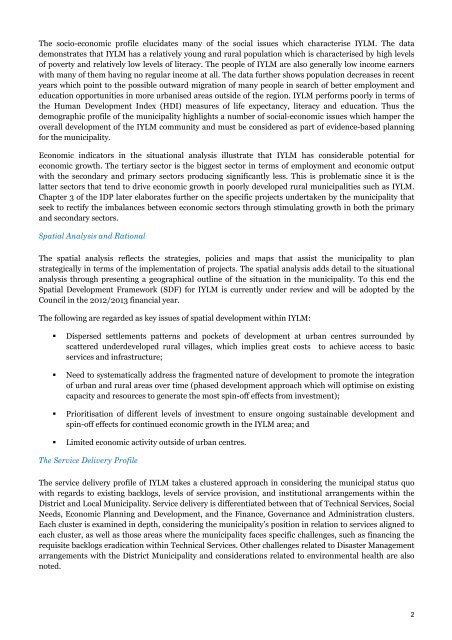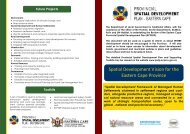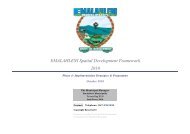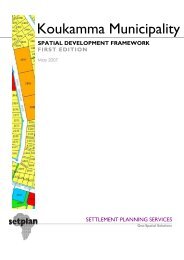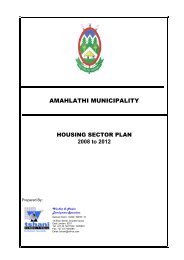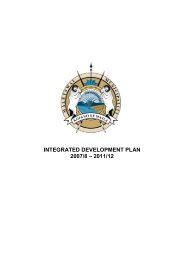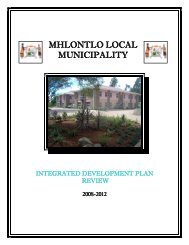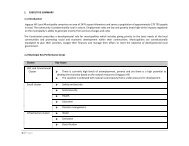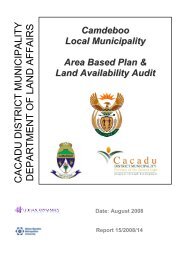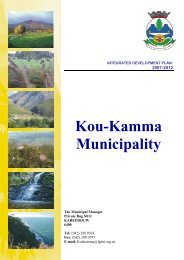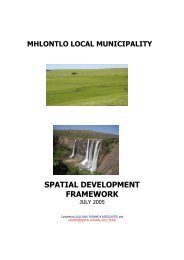intsika yethu local municipality - Provincial Spatial Development plan
intsika yethu local municipality - Provincial Spatial Development plan
intsika yethu local municipality - Provincial Spatial Development plan
You also want an ePaper? Increase the reach of your titles
YUMPU automatically turns print PDFs into web optimized ePapers that Google loves.
The socio-economic profile elucidates many of the social issues which characterise IYLM. The datademonstrates that IYLM has a relatively young and rural population which is characterised by high levelsof poverty and relatively low levels of literacy. The people of IYLM are also generally low income earnerswith many of them having no regular income at all. The data further shows population decreases in recentyears which point to the possible outward migration of many people in search of better employment andeducation opportunities in more urbanised areas outside of the region. IYLM performs poorly in terms ofthe Human <strong>Development</strong> Index (HDI) measures of life expectancy, literacy and education. Thus thedemographic profile of the <strong>municipality</strong> highlights a number of social-economic issues which hamper theoverall development of the IYLM community and must be considered as part of evidence-based <strong>plan</strong>ningfor the <strong>municipality</strong>.Economic indicators in the situational analysis illustrate that IYLM has considerable potential foreconomic growth. The tertiary sector is the biggest sector in terms of employment and economic outputwith the secondary and primary sectors producing significantly less. This is problematic since it is thelatter sectors that tend to drive economic growth in poorly developed rural municipalities such as IYLM.Chapter 3 of the IDP later elaborates further on the specific projects undertaken by the <strong>municipality</strong> thatseek to rectify the imbalances between economic sectors through stimulating growth in both the primaryand secondary sectors.<strong>Spatial</strong> Analysis and RationalThe spatial analysis reflects the strategies, policies and maps that assist the <strong>municipality</strong> to <strong>plan</strong>strategically in terms of the implementation of projects. The spatial analysis adds detail to the situationalanalysis through presenting a geographical outline of the situation in the <strong>municipality</strong>. To this end the<strong>Spatial</strong> <strong>Development</strong> Framework (SDF) for IYLM is currently under review and will be adopted by theCouncil in the 2012/2013 financial year.The following are regarded as key issues of spatial development within IYLM:• Dispersed settlements patterns and pockets of development at urban centres surrounded byscattered underdeveloped rural villages, which implies great costs to achieve access to basicservices and infrastructure;• Need to systematically address the fragmented nature of development to promote the integrationof urban and rural areas over time (phased development approach which will optimise on existingcapacity and resources to generate the most spin-off effects from investment);• Prioritisation of different levels of investment to ensure ongoing sustainable development andspin-off effects for continued economic growth in the IYLM area; and• Limited economic activity outside of urban centres.The Service Delivery ProfileThe service delivery profile of IYLM takes a clustered approach in considering the municipal status quowith regards to existing backlogs, levels of service provision, and institutional arrangements within theDistrict and Local Municipality. Service delivery is differentiated between that of Technical Services, SocialNeeds, Economic Planning and <strong>Development</strong>, and the Finance, Governance and Administration clusters.Each cluster is examined in depth, considering the <strong>municipality</strong>’s position in relation to services aligned toeach cluster, as well as those areas where the <strong>municipality</strong> faces specific challenges, such as financing therequisite backlogs eradication within Technical Services. Other challenges related to Disaster Managementarrangements with the District Municipality and considerations related to environmental health are alsonoted.2


